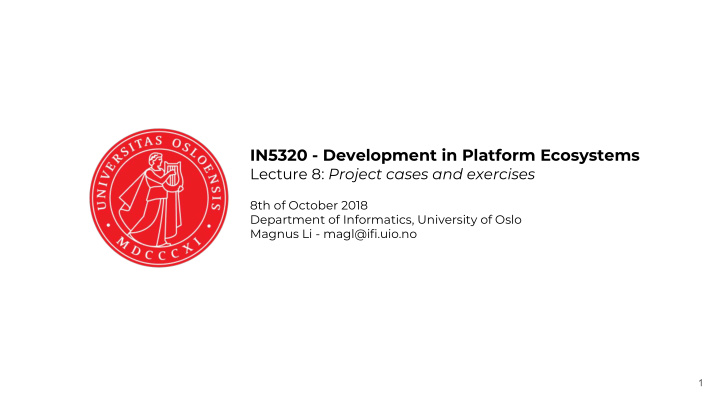



IN5320 - Development in Platform Ecosystems Lecture 8: Project cases and exercises 8th of October 2018 Department of Informatics, University of Oslo Magnus Li - magl@ifi.uio.no 1
Today 1. Project cases 2. Project process 3. Evaluation and grading 4. Defining platforms (discussions) 2
Tomorrow Presentations of available master-theses at the Information Systems research group. - 16:00 - Room Prolog (2nd floor) - Pizza 3
Project cases 4
Project - 5 cases that describe context and use-case. - Select one. - Flexibility. - Presentation 1 & 2 to provide guidance. - Justify decisions in final presentation. - The group teachers are available for guidance throughout the process 5
Next two weeks 6
Project timeline Week 41 - Requirements and Week 42 - Group presentation 1 low-fidelity Week 43 - lecture on DHIS2 as platform Week 44 - lecture on DHIS2 development Week 45 - Implement high-fidelity and Week 46 - Group presentation 2 communication with DHIS2 Week 47 - Week 48 - Final presentation 7
First two weeks + presentation 1 The next two weeks your group should: 1. Decide on a case. 2. Analyze the case description thoroughly. 3. Discuss and brainstorm to define requirements. Think about the following: a. Functionality (functional requirements) b. UI and non-functional requirements c. Implementation (just abstract, until lecture on dhis2 development). d. What you need from the DHIS2 API e. Assumptions and unclarities in the case. 4. Present requirements and visualizations/prototypes (e.g., paper-sketches of UI, data storage, what communication is needed with the API etc.). Discuss assumptions and unclarities. 8
Friday 10:15 - 12:00 Tuesday 12:15 - 14:00 Friday 12:15 - 14:00 Wednesday 10:15 - 12:00 9
Evaluation and grading 10
Evaluation of project Presentation 1 & 2 - for your group to get feedback and supervision (not graded) Presentation 3 - demonstrate solution and reflect on process (graded) Final solution/product will be tested and investigated before the presentation. 11
Evaluation of project Reflection upon work Implementation / code - Decisions on functionality - Use of API (efficiency, etc.) - Decisions on design - Quality of code (modularization, etc.) - Decisions on implementation Design - Process - User-friendliness Functionality - Sensitive to context - Solves key issues - Additional functionality - Usefulness - Robustness 12
Evaluating and grading the projects 13
Evaluation of project Part A C E Reflection Demonstrates excellent Demonstrates a reasonable Demonstrates a very judgement and a high degree degree of judgement and limited degree of of independent thinking. independent thinking. judgement and independent thinking. Functionality Beyond expected. The As expected. The app Less than expected. application has a variety of provides robust functionality Functionality that partly useful and robust functionality needed to solve the solves the fundamental beyond solving the fundamental challenges. challenges. fundamental challenges. Implementation Excellent use of API in terms of Sufficient use of API and the API are not used efficiency. Code is robust and code is relatively robust, optimally, and the code is very well structured and structured and modularized. unstructured. modularized. Design The application is clearly The application is relatively Context and users have designed with the users and user-friendly and sensitive to clearly not been of focus 14 context of use in mind. the context of use. in the design.
Defining platforms 15
Theoretical assignments 16
Platform Ecosystems Reflect alone, or discuss with fellow students: Choose two examples of platform ecosystems that you know. Baldwin and Woodard (2008) define platform architectures as something consisting of 1) A set of stable components 2) A set of complementary components that vary --- What are these in your example? 17
Platform Ecosystems Reflect alone, or discuss with fellow students: Tiwana (2013): “A software platform is a software-based product or service that serves as a foundation on which outside parties can build complementary products or services” --- Does this apply for your examples? If no: find another example and try again. If yes: Who owns the platforms? Who can build complementary products? And what can they build? 18
Platform Ecosystems Reflect alone, or discuss with fellow students: “To successfully build platform ecosystems, the focus of the platform owner must shift from developing applications to providing resources that support third-party developers in their development work” - Ghazawneh & Henfridsson 2013 p 174 → Boundary resources: resources enabling third party development through tools and regulations --- What boundary resources exists within your examples of ecosystems? How do they impact and shape the activities in the ecosystems? 19
Platform Ecosystems Reflect alone, or discuss with fellow students: According to Tiwana (2013), platforms are multisided. --- What “sides” exist in your examples? Are there any network effects? Cross-sided, same-sided? 20
Platform Ecosystems Reflect alone, or discuss with fellow students: Tiwana (2013) argues that multihoming, tipping, lock-in, competitive durability, and envelopment are typical phenomenons / aspects of platform ecosystems. In relation to your examples, discuss: - Multihoming - Tipping - Lock-ins - Competitive durability - Envelopment (Definitions can be found on the slides for last weeks lecture) 21
Recommend
More recommend